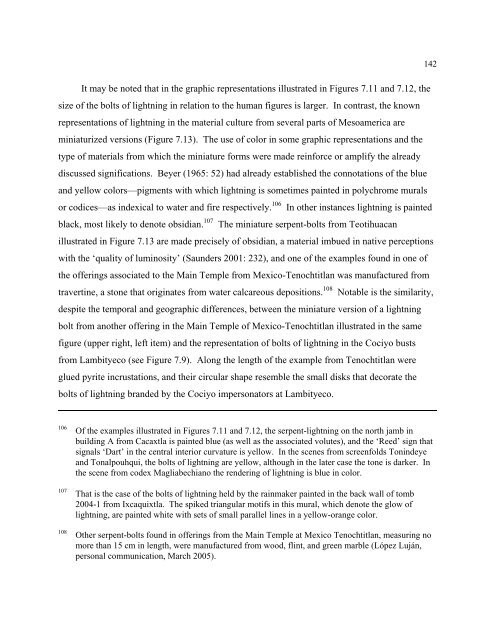Create successful ePaper yourself
Turn your PDF publications into a flip-book with our unique Google optimized e-Paper software.
It may be noted that in the graphic representations illustrated in Figures 7.11 and 7.12, the<br />
size of the bolts of lightning in relation to the human figures is larger. In contrast, the known<br />
representations of lightning in the material culture from several parts of Mesoamerica are<br />
miniaturized versions (Figure 7.13). The use of color in some graphic representations and the<br />
type of materials from which the miniature forms were made reinforce or amplify the already<br />
discussed significations. Beyer (1965: 52) had already established the connotations of the blue<br />
and yellow colors—pigments with which lightning is sometimes painted in polychrome murals<br />
or codices—as indexical to water and fire respectively. 106 In other instances lightning is painted<br />
black, most likely to denote obsidian. 107 The miniature serpent-bolts from Teotihuacan<br />
illustrated in Figure 7.13 are made precisely of obsidian, a material imbued in native perceptions<br />
with the ‘quality of luminosity’ (Saunders 2001: 232), and one of the examples found in one of<br />
the offerings associated to the Main Temple from Mexico-Tenochtitlan was manufactured from<br />
travertine, a stone that originates from water calcareous depositions. 108 Notable is the similarity,<br />
despite the temporal and geographic differences, between the miniature version of a lightning<br />
bolt from another offering in the Main Temple of Mexico-Tenochtitlan illustrated in the same<br />
figure (upper right, left item) and the representation of bolts of lightning in the Cociyo busts<br />
from Lambityeco (see Figure 7.9). Along the length of the example from Tenochtitlan were<br />
glued pyrite incrustations, and their circular shape resemble the small disks that decorate the<br />
bolts of lightning branded by the Cociyo impersonators at Lambityeco.<br />
106 Of the examples illustrated in Figures 7.11 and 7.12, the serpent-lightning on the north jamb in<br />
building A from Cacaxtla is painted blue (as well as the associated volutes), and the ‘Reed’ sign that<br />
signals ‘Dart’ in the central interior curvature is yellow. In the scenes from screenfolds Tonindeye<br />
and Tonalpouhqui, the bolts of lightning are yellow, although in the later case the tone is darker. In<br />
the scene from codex Magliabechiano the rendering of lightning is blue in color.<br />
107 That is the case of the bolts of lightning held by the rainmaker painted in the back wall of tomb<br />
2004-1 from Ixcaquixtla. The spiked triangular motifs in this mural, which denote the glow of<br />
lightning, are painted white with sets of small parallel lines in a yellow-orange color.<br />
108 Other serpent-bolts found in offerings from the Main Temple at Mexico Tenochtitlan, measuring no<br />
more than 15 cm in length, were manufactured from wood, flint, and green marble (López Luján,<br />
personal communication, March 2005).<br />
142

















